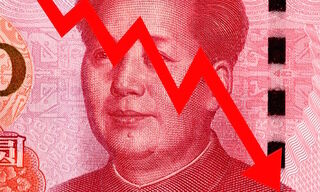A commentary from Juan Nevado, portfolio manager of M&G’s multi-asset strategy on the recent events China
Focus on China’s economic weakness and persistently low commodity prices has driven a sharp sell-off in ‘risk’ assets in recent days as investors ran for cover in ‘safe’ assets such as gold and US Treasuries. Equities are once again facing the macroeconomic headwind of a sentiment-driven and risk-averse environment. Nevertheless, the market panic around the world could well create opportunities, particularly in markets where prices have fallen sharply but where the fundamentals remain encouraging.
In this note, the M&G Multi Asset team discuss their views on the drivers of recent volatility and how they have responded across the funds.
Key points:
- These latest moves in the Chinese currency should not in themselves have a huge impact on fundamentals globally.
- Although there are genuine fundamental risks in China, it is not exactly a ‘sudden growth shock’ that has triggered the most recent declines – there has been evidence of a Chinese slowdown since the beginning of the year.
- So it seems more that perceptions, rather than fundamentals, have changed following the People’s Bank of China’s surprise move to devalue the currency, as well as an element of price-driving-price.
- Therefore, the team view recent market movements as an opportunity to take advantage of more attractive valuations in certain areas, primarily developed market equity where fundamentals remain supportive, which are less likely to be affected over the longer term by developments in China.
The emphasis in markets has sharply reversed from a Western recovery/US policy story to a China growth risk/need for more effective policy action story. With the falling oil price bolstering demand for more policy action, investors are asking why central bankers are not doing more, given that there is no sign of inflation?
There seems to be a growing lack of confidence in policymakers to counteract Asian/emerging market growth risks; in an environment where investors remain keenly focused on policy globally, this is weighing heavily on sentiment.
These latest moves in the Chinese currency should not in themselves have a huge impact on fundamentals globally. Free-floating currencies move by similar or larger amounts frequently, it is also worth putting the move into context – the strength of the US dollar means that the CNY had appreciated versus a trade-weighted basket by around 20% since the middle of 2014 before the latest move.
The extreme price reaction seems therefore to be function of other, related concerns either the growth picture in China is somehow worse than previously thought, the PBoC may been engaging on a path which could result in policy error, or the currency move itself could harm Chinese growth due to companies being unable to make debt payments denominated in foreign currencies.
The fundamental picture in China has not changed (the currency move should be a benefit if anything). Although there are genuine fundamental risks in China, it is not exactly a ‘sudden growth shock’ that has triggered most recent declines – there has been evidence of a Chinese slowdown since the beginning of the year. But the People’s Bank of China’s sudden devaluation of the yuan earlier this month surprised markets and grabbed attention. These devaluations have been limited, but combined with further weak data (China’s manufacturing PMI reaching 47.1, for example) and the unwillingness of Chinese policymakers to reduce the reserve requirement ratio (RRR), they have sparked concern among investors.
So it seems more that perceptions, rather than fundamentals, have changed because of price action. We often comment that markets do not necessarily respond to developments in the most logical timeframe. There are always a great number of factors occurring across the global economy at any time that investors could choose to focus on. Often, when investors are feeling negative, they will focus on the factors that reinforce that view – and vice versa. Therefore, much of the complexity of markets becomes distilled into a single story, enabling these sudden swings in sentiment to escalate.
In this instance, as often during such episodes, there does seem to be a fair bit of price-driving-price around the China issue in recent weeks. This means that although we cannot say China’s issues are just ‘noise’, there has more recently been a lot of noise around the topic, reflected in headlines focusing on fairly meaningless things such as indices falling through certain levels.
With our view being that the recent very strong sell-off across global equities reflects changing sentiment more than fundamentals, it feels that we are entering ‘episodic’ territory, where opportunities may be presented as a result of investors overreacting in the short term.
Yes, there are genuine concerns in terms of Asian growth which could trigger lower demand and fundamentals may deteriorate in some respects. Markets have obviously sharply priced in a change in sentiment while China has been dominating headlines, but we cannot know whether all risks are yet fully priced in. However, some assets further away have also just got a lot cheaper rather quickly and it may make sense to sniff opportunities in markets that have sold off, but where fundamentals are still looking pretty strong.
In line with our investment philosophy, we continue to remain watchful for further opportunities – as well as risks – that could be presented by markets overreacting to short-term news flow.




















